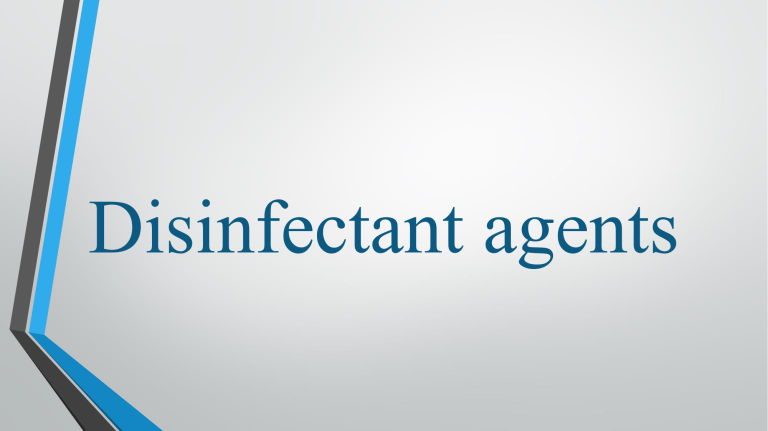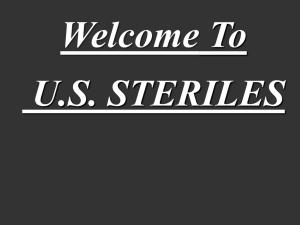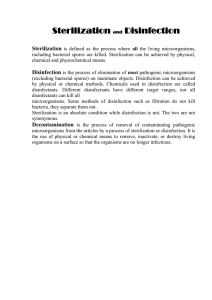
Disinfectant agents Def: Is the process of destruction or removal of microorganisms and reducing them to the level not harmful to health . If the object is inanimate (lifeless) ,such as working area ,dishes ,benches , etc. The chemical agent is know as disinfectants. However if the object is animate (living) such as human body tissue ,the chemical is know as antiseptic . Types: High level disinfection. Intermediate level disinfection . Low level disinfection . High level disinfection High level disinfection destroy vegetative bacteria ,mycobacteria ,fungi and enveloped (lipid) and non enveloped (non lipid) viruses but not necessarily bacterial spores . It must be capable of sterilization when contact time is extended. Intermediate level disinfection: Intermediate level disinfection kill vegetative bacteria ,most viruses and most fungi but not resistance bacteria spores . Low level disinfection : kill most vegetative bacteria and some fungi , don’t kill mycobacteria or bacteria spores . Used to clean environmental surfaces . An ideal disinfectant should have following properties : Broad spectrum. Economical. Non toxic. Easy to use . Fast acting. Soluble. Odorless. not affected by the physical factor Surface compatibility. Stable on storage . Classification of disinfectants: Acid and alkalis. Dyes. Halogens. Quaternary ammonium compounds. Heavy metals Detergents and soups Phenol and its derivatives. Heat . Alcohols. Radiation . Aldehydes. Filtration. 1-Acid and alkalis: strong acids and alkali kill the bacteria but weak organic acids inhibit their growth. 2-Halogens :chlorine ,fluorine, bromine and iodine in the free state as well as their compouds strongly act as germicidal. 3-Heavy metals : the most widely used heavy metals are those of mercury , silver. -it act as antimicrobial by combining with influence with the cellular protein. -high concentration of salts and heavy metals like mercury , cooper and silver coagulate cytoplasm protein , resulting in damage or cell death . 4- phenol and its derivatives : is the cheap product obtain by the distillation of the cool tar . -phenol 1% has bactericidal action . - many derivatives of phenol are more effective and less costly . 5- Alcohols : it have fairly rapid bactericidal action against vegetative bacteria when polluted to concentration of 60% to 70% v/v with water . -ethanol 60%to 70% v/v and isopropanol 50%to 60% v/v are used as skin disinfectants while methanol vapor has been used as fungicide . -The higher alcohols (propyl , butyl, amyl etc. ) are more germicidal than ethyl alcohol . -alcohols are used as preservatives in some vaccines . 6- Aldehyde : formaldehyde is the main aldehyde used for disinfection. -formaldehyde in solution is useful for sterilization of certain instruments . 7- Quaternary ammonium compound : are widely used for the control of microorganism on floor , walls , nursing home and other public places . -they are also used as skin antiseptics and as sanitization agent in dray ,egg and fishing industries . 8- Dyes : a number of dyes have been used to inhibit the bacterial growth . -basic dyes are more effective bactericide than acidic dyes. -acridine and triphenylmethane dyes are commonly used as antimicrobial agents. 9- Detergents and soaps : they are widely used as surface active agents , wetting agents and emulsifiers . -they are classified into four main groups such as anionic , cationic , non-ionic and amphoteric . Mode of action of disinfectants : Alteration of membrane permeability . Damage to protein . Rupture of cell membrane. Damage to nucleic acid . Interfere with metabolic pathway . Factor affecting disinfection : Concentration of disinfected. Formulation of disinfectant. Temperature. Chemical structure of disinfectant Time of contact . Types and number of microorganism PH of environment . present. Surface tension. . Presented by : Rasha elsayed. Asmaa Mohammed. AYA Mohammed elsayed. Ahmed Esmat. Mohammed elwaey Ebrahim zamzam. Mohammed elashery. Ahmed Khaled Ahmed Salama.

